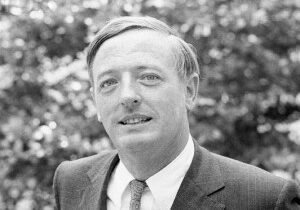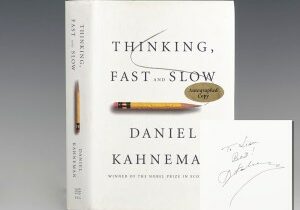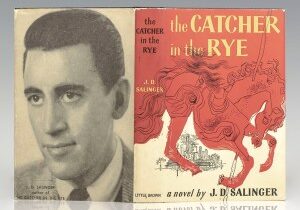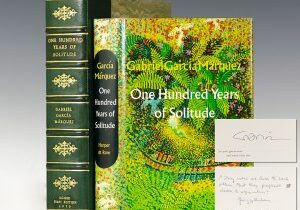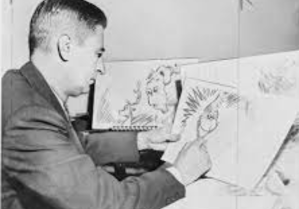Wednesday, October 2, 2019 marks the 150th anniversary of the Father of the Nation of India, Mahatma Gandhi’s birth. A national holiday in India, the day is celebrated worldwide as the International Day of Nonviolence. Born on October 2, 1869, Mohandas Karamchand Gandhi was trained in law at the Inner Temple, London, and called to the bar at age 22. He moved to South Africa in 1893 where resided for 21 years and adopted his still evolving methodology of Satyagraha (devotion to the truth), or nonviolent protest, for the first time in the wake of the Boer War.

Rare engraving of one of the most famous graphic images of Gandhi by illustrator Fritz Eichenberg; signed and inscribed by Ghandi and signed by Eichenberg
In 1915, Gandhi returned to India with an international reputation as a leading Indian nationalist, theorist and community organizer. He joined the Indian National Congress, assuming leadership in 1921 and led nationwide campaigns to ease poverty, expand women’s rights, and, above all, achieve Indian independence from British rule. In the wake of World War II, Gandhi opposed providing any help to the British war effort and campaigned against any Indian participation in the war.

First American edition of Gandhi’s Songs from Prison
As the war progressed, Gandhi intensified his demand for independence, calling for the British to Quit India in a 1942 speech in Mumbai, hours after which he was arrested by the British government. Gandhi’s imprisonment lasted two years, although he was initially sentenced to six. He was released in May of 1944 due to failing health.

Rare Mohandas K. Gandhi autograph, signed at the height of the struggle for Indian Independence in 1938
Following the end of WWII, the new British government passed the Indian Independence Act of 1947, partitioning the British Indian Empire was into two dominions, a Hindu-majority India and Muslim-majority Pakistan. As many displaced Hindus, Muslims, and Sikhs made their way to their new lands, religious violence broke out, especially in the Punjab and Bengal. Eschewing the official celebration of independence in Delhi, Gandhi visited the affected areas, attempting to provide solace. In the months following, he undertook several fasts unto death to stop religious violence. In 1948, Gandhi was assassinated on his way to a prayer meeting in the Birla House garden. His death was mourned nationwide; over two million people joined the five-mile long funeral procession in his honor.

Second edition of Young India; signed and dated by Gandhi
Gandhi was a prolific writer throughout his lifetime. He founded and published two periodicals to spread the philosophy and principles of the Satyagraha Movement and urge readers to participate in it: English weekly periodical Young India in 1919, and the weekly Gujarati magazine Navjivan in 1925.

First editions of Gandhi’s fundamental autobiography The Story of My Experiments with Truth; inscribed by him to Raja Shamraj Rajwant Bahadur who assembled India’s greatest library
First published in weekly installments in Navjivan, Gandhi’s autobiography, The Story of My Experiments with Truth was published in book form in two volumes between 1927 and 1929. “My purpose,” he wrote of the book, “is to describe experiments in the science of Satyagraha, not to say how good I am.” Written at the insistence of his closest collaborators to explain the background of his public campaigns, the work covered Gandhi’s life from early childhood through 1921. In the work, Gandhi noted that the three most important modern influences in his life were Leo Tolstoy’s The Kingdom of God Is Within You, John Ruskin’s Unto This Last, and the poet Shrimad Rajchandra (Raychandbhai).

First edition of Gandhi’s Non-Violence in Peace & War
Published in Navajivan between 1949 and 1949, Gandhi’s Non-Violence in Peace & War further crystallized his philosophy of Satyagraha, in it he wrote: “An unjust law is itself a species of violence. Arrest for its breach is more so. Now the law of nonviolence says that violence should be resisted not by counter-violence but by nonviolence. This I do by breaking the law and by peacefully submitting to arrest and imprisonment.”

Rare signed photograph of Gandhi; with an autographed letter signed from Amrit Kaur, the secretary to Gandhi and later Health Minister of India
Gandhi’s vision and effective use of non-violent action inspired movements for civil rights and freedom across the world. View the all of the works written and signed by Gandhi here, as well as works and documents signed by two of his proteges: Indian Prime Minister Jawaharlal Nehru and civil rights leader Martin Luther King, Jr.

